Developing a Crisis Manual: IKEA Public Relations Crisis Management
VerifiedAdded on 2023/06/08
|12
|2849
|84
Portfolio
AI Summary
This assignment presents a crisis manual developed in response to the IKEA dresser recall crisis, focusing on public relations and crisis management strategies. The manual outlines objectives for managing crises, identifies different types of crises relevant to IKEA (including product-related issues, labor conflicts, and external threats), and lists key internal and external publics that need to be notified during a crisis. It details the composition and roles of the crisis communication team, emphasizes the importance of trained spokespeople, and specifies necessary resources and pre-gathered documents for effective crisis response. The manual also includes a sample press release addressing the extension of the dresser recall to China following criticism. The document emphasizes proactive planning, clear communication, and coordinated action to mitigate the impact of potential crises on IKEA's operations and reputation. Desklib provides students access to this and other solved assignments.
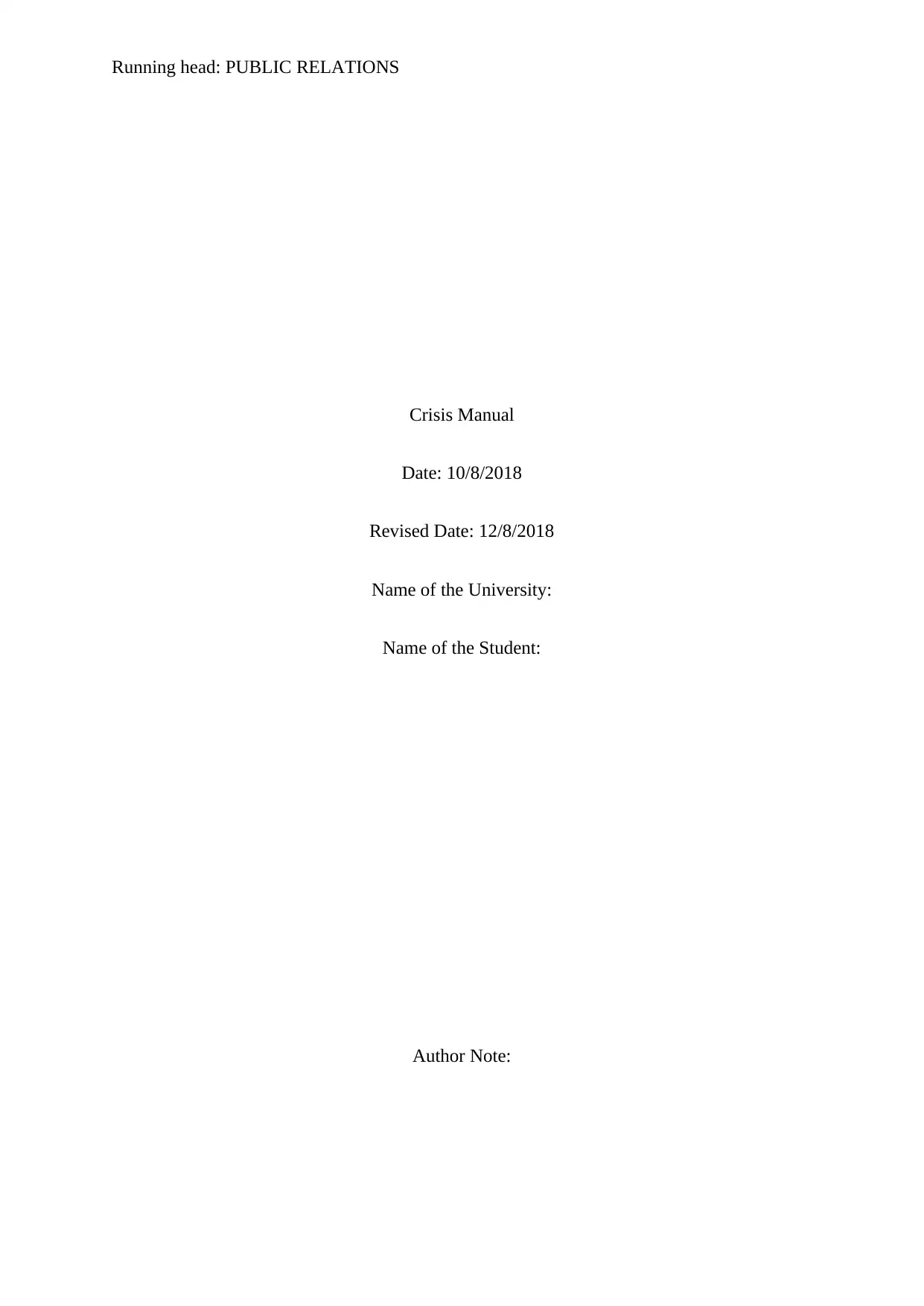
Running head: PUBLIC RELATIONS
Crisis Manual
Date: 10/8/2018
Revised Date: 12/8/2018
Name of the University:
Name of the Student:
Author Note:
Crisis Manual
Date: 10/8/2018
Revised Date: 12/8/2018
Name of the University:
Name of the Student:
Author Note:
Paraphrase This Document
Need a fresh take? Get an instant paraphrase of this document with our AI Paraphraser
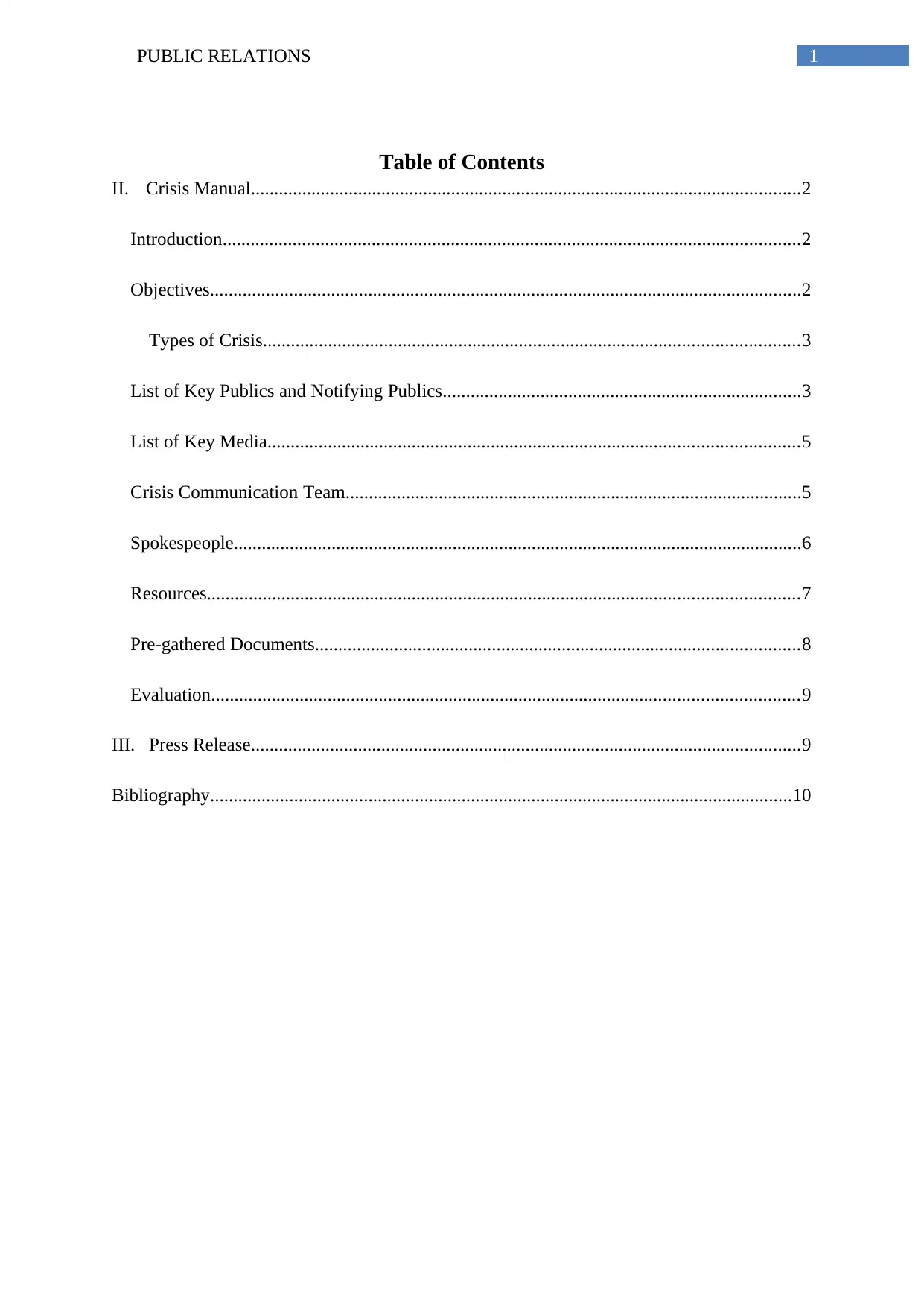
1PUBLIC RELATIONS
Table of Contents
II. Crisis Manual......................................................................................................................2
Introduction............................................................................................................................2
Objectives...............................................................................................................................2
Types of Crisis...................................................................................................................3
List of Key Publics and Notifying Publics.............................................................................3
List of Key Media..................................................................................................................5
Crisis Communication Team..................................................................................................5
Spokespeople..........................................................................................................................6
Resources...............................................................................................................................7
Pre-gathered Documents........................................................................................................8
Evaluation..............................................................................................................................9
III. Press Release......................................................................................................................9
Bibliography.............................................................................................................................10
Table of Contents
II. Crisis Manual......................................................................................................................2
Introduction............................................................................................................................2
Objectives...............................................................................................................................2
Types of Crisis...................................................................................................................3
List of Key Publics and Notifying Publics.............................................................................3
List of Key Media..................................................................................................................5
Crisis Communication Team..................................................................................................5
Spokespeople..........................................................................................................................6
Resources...............................................................................................................................7
Pre-gathered Documents........................................................................................................8
Evaluation..............................................................................................................................9
III. Press Release......................................................................................................................9
Bibliography.............................................................................................................................10
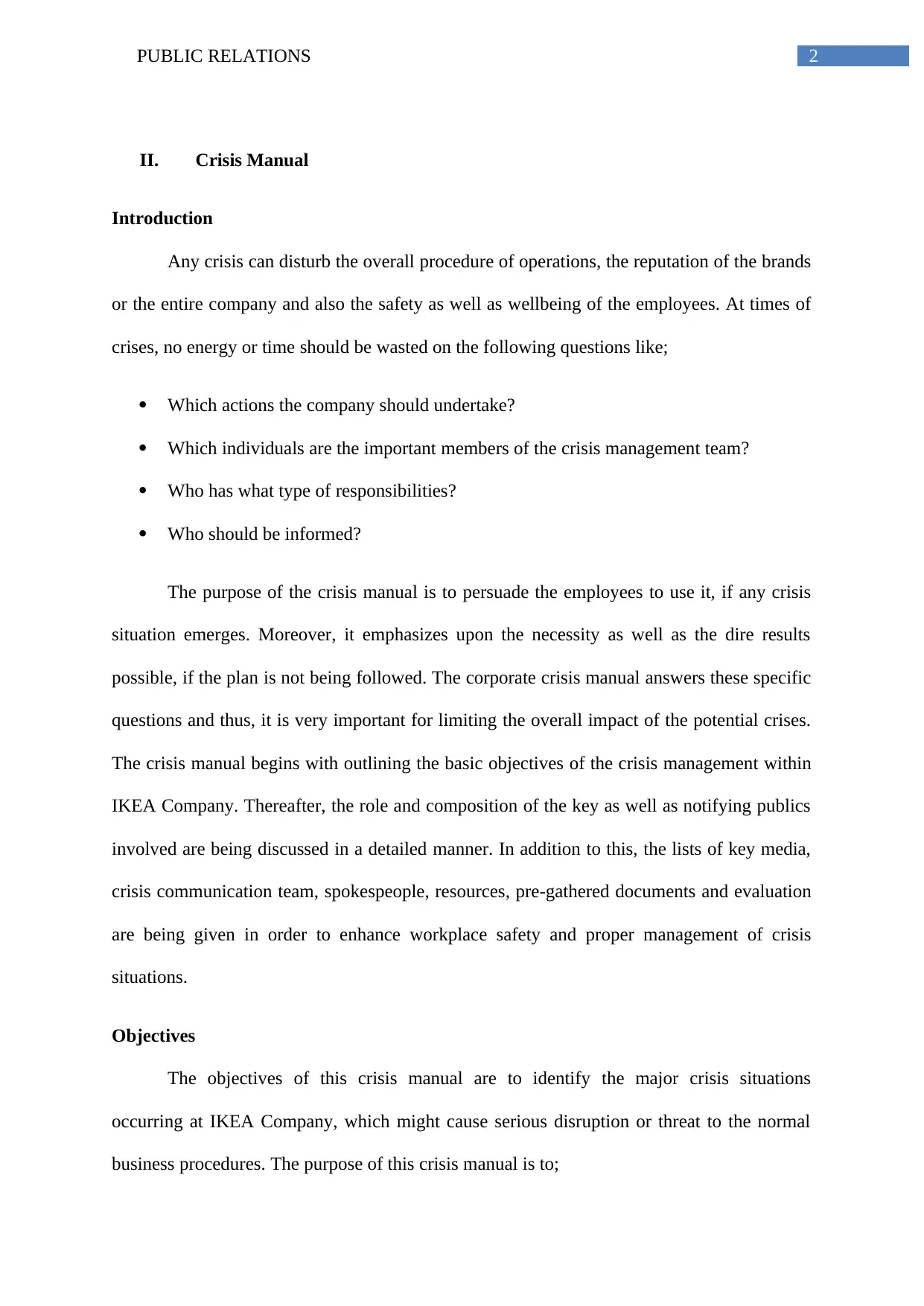
2PUBLIC RELATIONS
II. Crisis Manual
Introduction
Any crisis can disturb the overall procedure of operations, the reputation of the brands
or the entire company and also the safety as well as wellbeing of the employees. At times of
crises, no energy or time should be wasted on the following questions like;
Which actions the company should undertake?
Which individuals are the important members of the crisis management team?
Who has what type of responsibilities?
Who should be informed?
The purpose of the crisis manual is to persuade the employees to use it, if any crisis
situation emerges. Moreover, it emphasizes upon the necessity as well as the dire results
possible, if the plan is not being followed. The corporate crisis manual answers these specific
questions and thus, it is very important for limiting the overall impact of the potential crises.
The crisis manual begins with outlining the basic objectives of the crisis management within
IKEA Company. Thereafter, the role and composition of the key as well as notifying publics
involved are being discussed in a detailed manner. In addition to this, the lists of key media,
crisis communication team, spokespeople, resources, pre-gathered documents and evaluation
are being given in order to enhance workplace safety and proper management of crisis
situations.
Objectives
The objectives of this crisis manual are to identify the major crisis situations
occurring at IKEA Company, which might cause serious disruption or threat to the normal
business procedures. The purpose of this crisis manual is to;
II. Crisis Manual
Introduction
Any crisis can disturb the overall procedure of operations, the reputation of the brands
or the entire company and also the safety as well as wellbeing of the employees. At times of
crises, no energy or time should be wasted on the following questions like;
Which actions the company should undertake?
Which individuals are the important members of the crisis management team?
Who has what type of responsibilities?
Who should be informed?
The purpose of the crisis manual is to persuade the employees to use it, if any crisis
situation emerges. Moreover, it emphasizes upon the necessity as well as the dire results
possible, if the plan is not being followed. The corporate crisis manual answers these specific
questions and thus, it is very important for limiting the overall impact of the potential crises.
The crisis manual begins with outlining the basic objectives of the crisis management within
IKEA Company. Thereafter, the role and composition of the key as well as notifying publics
involved are being discussed in a detailed manner. In addition to this, the lists of key media,
crisis communication team, spokespeople, resources, pre-gathered documents and evaluation
are being given in order to enhance workplace safety and proper management of crisis
situations.
Objectives
The objectives of this crisis manual are to identify the major crisis situations
occurring at IKEA Company, which might cause serious disruption or threat to the normal
business procedures. The purpose of this crisis manual is to;
⊘ This is a preview!⊘
Do you want full access?
Subscribe today to unlock all pages.

Trusted by 1+ million students worldwide
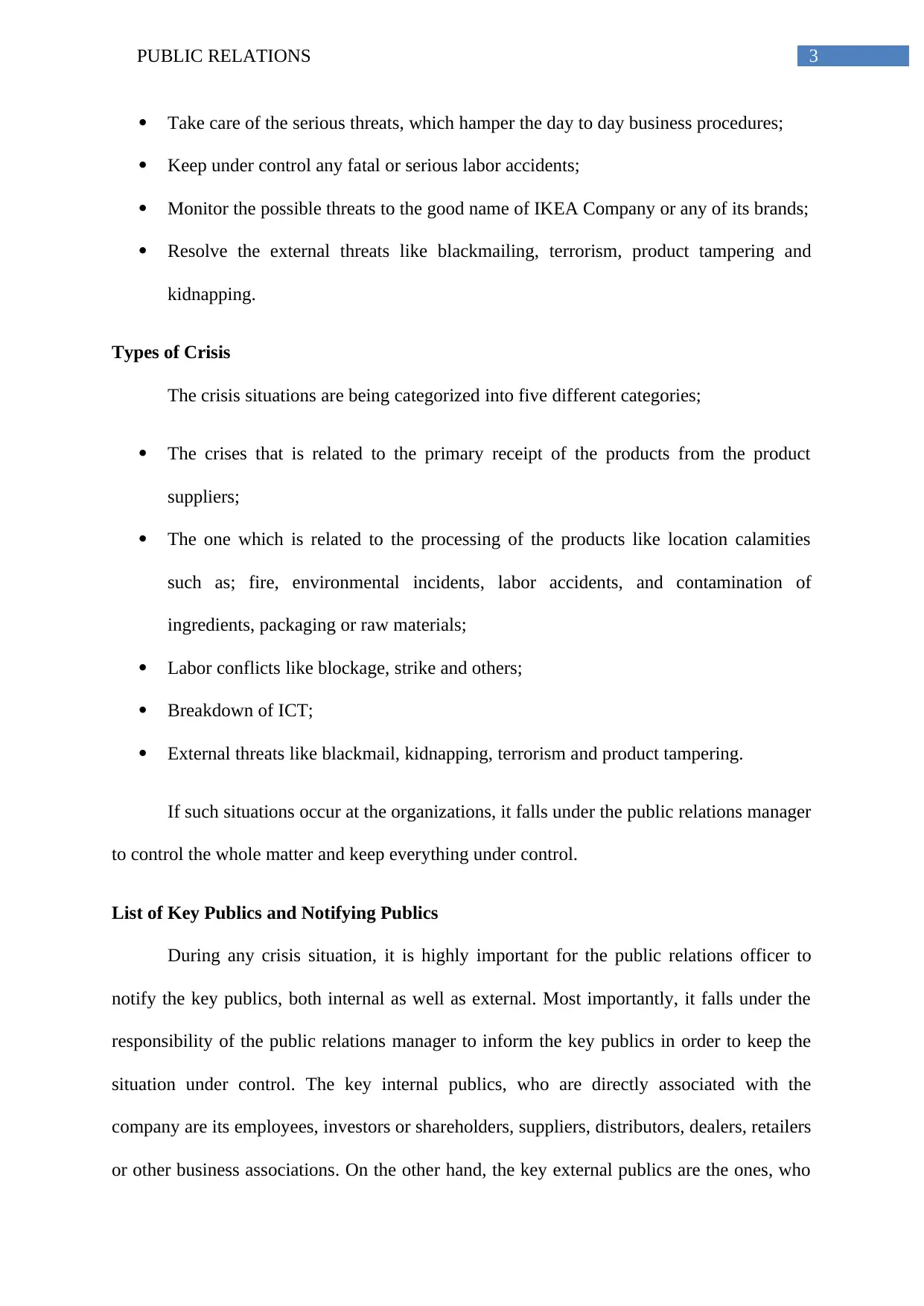
3PUBLIC RELATIONS
Take care of the serious threats, which hamper the day to day business procedures;
Keep under control any fatal or serious labor accidents;
Monitor the possible threats to the good name of IKEA Company or any of its brands;
Resolve the external threats like blackmailing, terrorism, product tampering and
kidnapping.
Types of Crisis
The crisis situations are being categorized into five different categories;
The crises that is related to the primary receipt of the products from the product
suppliers;
The one which is related to the processing of the products like location calamities
such as; fire, environmental incidents, labor accidents, and contamination of
ingredients, packaging or raw materials;
Labor conflicts like blockage, strike and others;
Breakdown of ICT;
External threats like blackmail, kidnapping, terrorism and product tampering.
If such situations occur at the organizations, it falls under the public relations manager
to control the whole matter and keep everything under control.
List of Key Publics and Notifying Publics
During any crisis situation, it is highly important for the public relations officer to
notify the key publics, both internal as well as external. Most importantly, it falls under the
responsibility of the public relations manager to inform the key publics in order to keep the
situation under control. The key internal publics, who are directly associated with the
company are its employees, investors or shareholders, suppliers, distributors, dealers, retailers
or other business associations. On the other hand, the key external publics are the ones, who
Take care of the serious threats, which hamper the day to day business procedures;
Keep under control any fatal or serious labor accidents;
Monitor the possible threats to the good name of IKEA Company or any of its brands;
Resolve the external threats like blackmailing, terrorism, product tampering and
kidnapping.
Types of Crisis
The crisis situations are being categorized into five different categories;
The crises that is related to the primary receipt of the products from the product
suppliers;
The one which is related to the processing of the products like location calamities
such as; fire, environmental incidents, labor accidents, and contamination of
ingredients, packaging or raw materials;
Labor conflicts like blockage, strike and others;
Breakdown of ICT;
External threats like blackmail, kidnapping, terrorism and product tampering.
If such situations occur at the organizations, it falls under the public relations manager
to control the whole matter and keep everything under control.
List of Key Publics and Notifying Publics
During any crisis situation, it is highly important for the public relations officer to
notify the key publics, both internal as well as external. Most importantly, it falls under the
responsibility of the public relations manager to inform the key publics in order to keep the
situation under control. The key internal publics, who are directly associated with the
company are its employees, investors or shareholders, suppliers, distributors, dealers, retailers
or other business associations. On the other hand, the key external publics are the ones, who
Paraphrase This Document
Need a fresh take? Get an instant paraphrase of this document with our AI Paraphraser
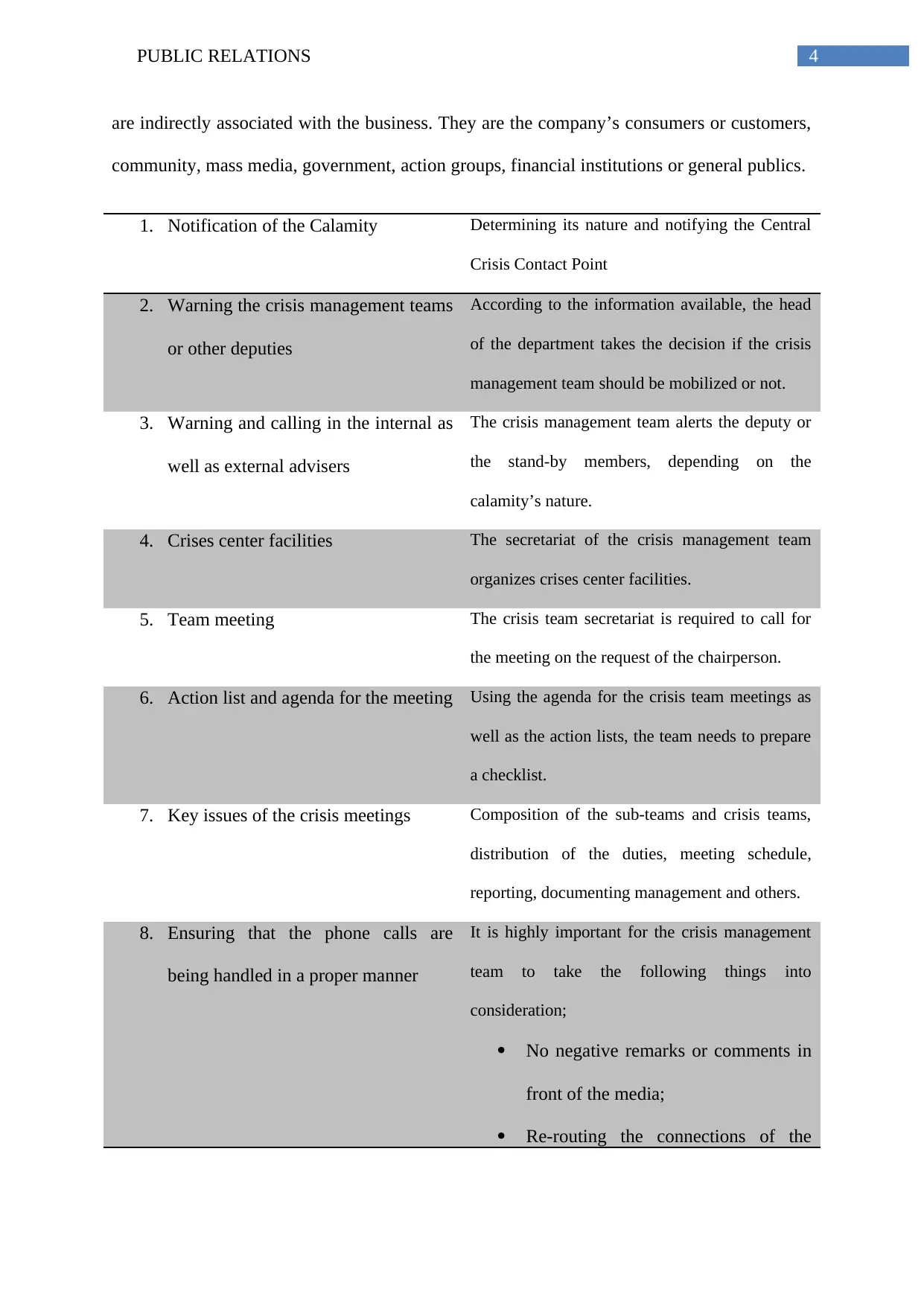
4PUBLIC RELATIONS
are indirectly associated with the business. They are the company’s consumers or customers,
community, mass media, government, action groups, financial institutions or general publics.
1. Notification of the Calamity Determining its nature and notifying the Central
Crisis Contact Point
2. Warning the crisis management teams
or other deputies
According to the information available, the head
of the department takes the decision if the crisis
management team should be mobilized or not.
3. Warning and calling in the internal as
well as external advisers
The crisis management team alerts the deputy or
the stand-by members, depending on the
calamity’s nature.
4. Crises center facilities The secretariat of the crisis management team
organizes crises center facilities.
5. Team meeting The crisis team secretariat is required to call for
the meeting on the request of the chairperson.
6. Action list and agenda for the meeting Using the agenda for the crisis team meetings as
well as the action lists, the team needs to prepare
a checklist.
7. Key issues of the crisis meetings Composition of the sub-teams and crisis teams,
distribution of the duties, meeting schedule,
reporting, documenting management and others.
8. Ensuring that the phone calls are
being handled in a proper manner
It is highly important for the crisis management
team to take the following things into
consideration;
No negative remarks or comments in
front of the media;
Re-routing the connections of the
are indirectly associated with the business. They are the company’s consumers or customers,
community, mass media, government, action groups, financial institutions or general publics.
1. Notification of the Calamity Determining its nature and notifying the Central
Crisis Contact Point
2. Warning the crisis management teams
or other deputies
According to the information available, the head
of the department takes the decision if the crisis
management team should be mobilized or not.
3. Warning and calling in the internal as
well as external advisers
The crisis management team alerts the deputy or
the stand-by members, depending on the
calamity’s nature.
4. Crises center facilities The secretariat of the crisis management team
organizes crises center facilities.
5. Team meeting The crisis team secretariat is required to call for
the meeting on the request of the chairperson.
6. Action list and agenda for the meeting Using the agenda for the crisis team meetings as
well as the action lists, the team needs to prepare
a checklist.
7. Key issues of the crisis meetings Composition of the sub-teams and crisis teams,
distribution of the duties, meeting schedule,
reporting, documenting management and others.
8. Ensuring that the phone calls are
being handled in a proper manner
It is highly important for the crisis management
team to take the following things into
consideration;
No negative remarks or comments in
front of the media;
Re-routing the connections of the
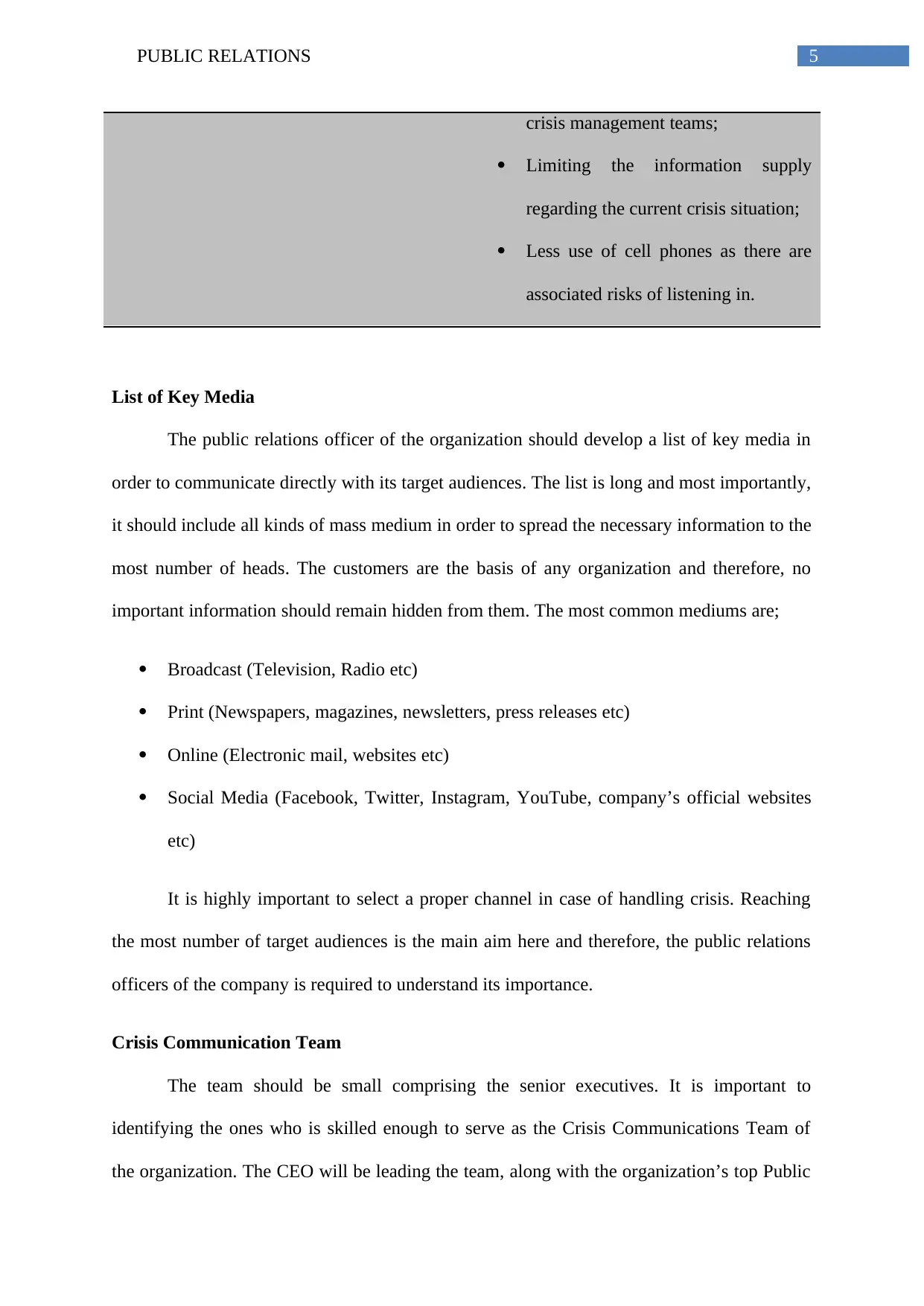
5PUBLIC RELATIONS
crisis management teams;
Limiting the information supply
regarding the current crisis situation;
Less use of cell phones as there are
associated risks of listening in.
List of Key Media
The public relations officer of the organization should develop a list of key media in
order to communicate directly with its target audiences. The list is long and most importantly,
it should include all kinds of mass medium in order to spread the necessary information to the
most number of heads. The customers are the basis of any organization and therefore, no
important information should remain hidden from them. The most common mediums are;
Broadcast (Television, Radio etc)
Print (Newspapers, magazines, newsletters, press releases etc)
Online (Electronic mail, websites etc)
Social Media (Facebook, Twitter, Instagram, YouTube, company’s official websites
etc)
It is highly important to select a proper channel in case of handling crisis. Reaching
the most number of target audiences is the main aim here and therefore, the public relations
officers of the company is required to understand its importance.
Crisis Communication Team
The team should be small comprising the senior executives. It is important to
identifying the ones who is skilled enough to serve as the Crisis Communications Team of
the organization. The CEO will be leading the team, along with the organization’s top Public
crisis management teams;
Limiting the information supply
regarding the current crisis situation;
Less use of cell phones as there are
associated risks of listening in.
List of Key Media
The public relations officer of the organization should develop a list of key media in
order to communicate directly with its target audiences. The list is long and most importantly,
it should include all kinds of mass medium in order to spread the necessary information to the
most number of heads. The customers are the basis of any organization and therefore, no
important information should remain hidden from them. The most common mediums are;
Broadcast (Television, Radio etc)
Print (Newspapers, magazines, newsletters, press releases etc)
Online (Electronic mail, websites etc)
Social Media (Facebook, Twitter, Instagram, YouTube, company’s official websites
etc)
It is highly important to select a proper channel in case of handling crisis. Reaching
the most number of target audiences is the main aim here and therefore, the public relations
officers of the company is required to understand its importance.
Crisis Communication Team
The team should be small comprising the senior executives. It is important to
identifying the ones who is skilled enough to serve as the Crisis Communications Team of
the organization. The CEO will be leading the team, along with the organization’s top Public
⊘ This is a preview!⊘
Do you want full access?
Subscribe today to unlock all pages.

Trusted by 1+ million students worldwide
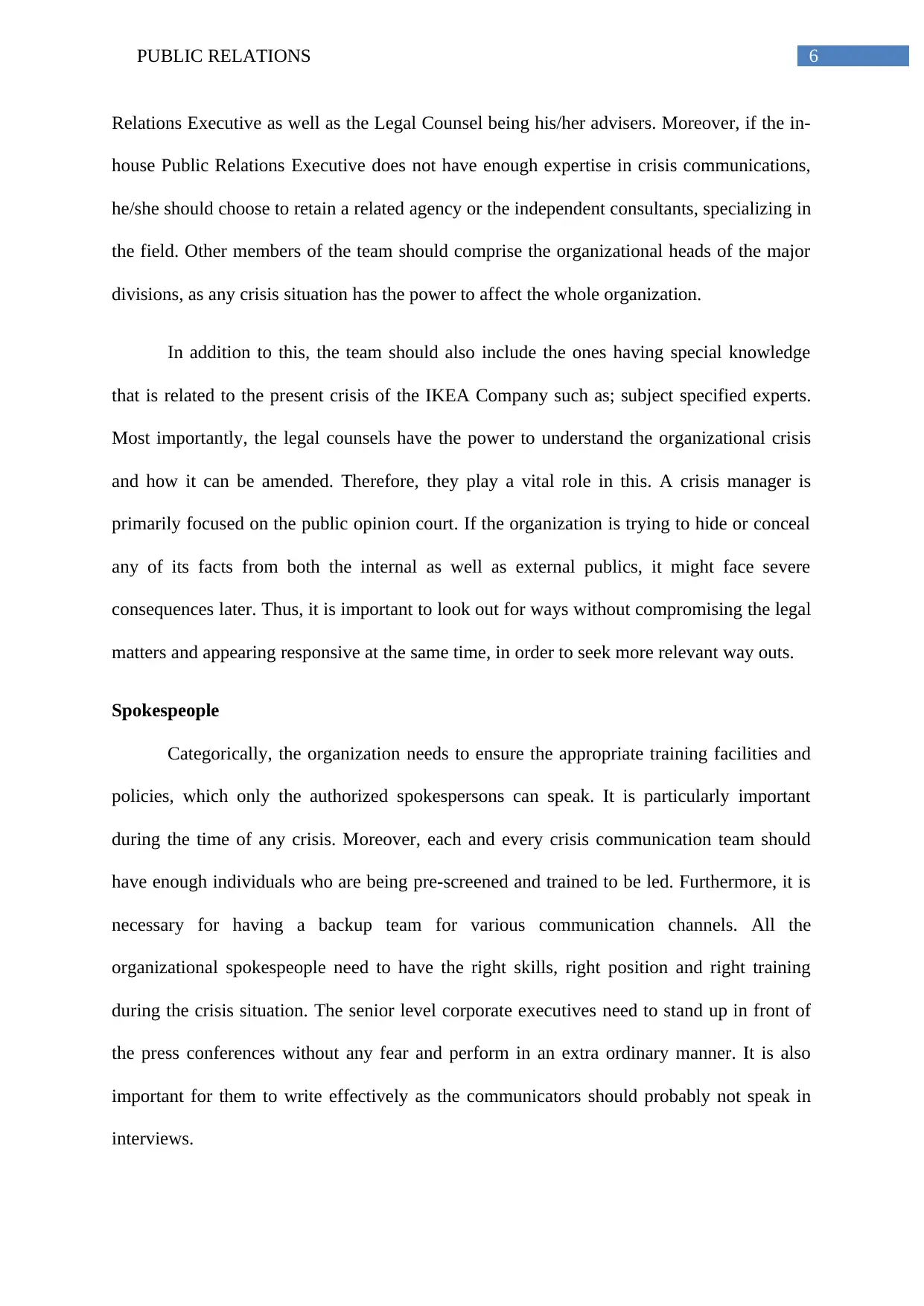
6PUBLIC RELATIONS
Relations Executive as well as the Legal Counsel being his/her advisers. Moreover, if the in-
house Public Relations Executive does not have enough expertise in crisis communications,
he/she should choose to retain a related agency or the independent consultants, specializing in
the field. Other members of the team should comprise the organizational heads of the major
divisions, as any crisis situation has the power to affect the whole organization.
In addition to this, the team should also include the ones having special knowledge
that is related to the present crisis of the IKEA Company such as; subject specified experts.
Most importantly, the legal counsels have the power to understand the organizational crisis
and how it can be amended. Therefore, they play a vital role in this. A crisis manager is
primarily focused on the public opinion court. If the organization is trying to hide or conceal
any of its facts from both the internal as well as external publics, it might face severe
consequences later. Thus, it is important to look out for ways without compromising the legal
matters and appearing responsive at the same time, in order to seek more relevant way outs.
Spokespeople
Categorically, the organization needs to ensure the appropriate training facilities and
policies, which only the authorized spokespersons can speak. It is particularly important
during the time of any crisis. Moreover, each and every crisis communication team should
have enough individuals who are being pre-screened and trained to be led. Furthermore, it is
necessary for having a backup team for various communication channels. All the
organizational spokespeople need to have the right skills, right position and right training
during the crisis situation. The senior level corporate executives need to stand up in front of
the press conferences without any fear and perform in an extra ordinary manner. It is also
important for them to write effectively as the communicators should probably not speak in
interviews.
Relations Executive as well as the Legal Counsel being his/her advisers. Moreover, if the in-
house Public Relations Executive does not have enough expertise in crisis communications,
he/she should choose to retain a related agency or the independent consultants, specializing in
the field. Other members of the team should comprise the organizational heads of the major
divisions, as any crisis situation has the power to affect the whole organization.
In addition to this, the team should also include the ones having special knowledge
that is related to the present crisis of the IKEA Company such as; subject specified experts.
Most importantly, the legal counsels have the power to understand the organizational crisis
and how it can be amended. Therefore, they play a vital role in this. A crisis manager is
primarily focused on the public opinion court. If the organization is trying to hide or conceal
any of its facts from both the internal as well as external publics, it might face severe
consequences later. Thus, it is important to look out for ways without compromising the legal
matters and appearing responsive at the same time, in order to seek more relevant way outs.
Spokespeople
Categorically, the organization needs to ensure the appropriate training facilities and
policies, which only the authorized spokespersons can speak. It is particularly important
during the time of any crisis. Moreover, each and every crisis communication team should
have enough individuals who are being pre-screened and trained to be led. Furthermore, it is
necessary for having a backup team for various communication channels. All the
organizational spokespeople need to have the right skills, right position and right training
during the crisis situation. The senior level corporate executives need to stand up in front of
the press conferences without any fear and perform in an extra ordinary manner. It is also
important for them to write effectively as the communicators should probably not speak in
interviews.
Paraphrase This Document
Need a fresh take? Get an instant paraphrase of this document with our AI Paraphraser
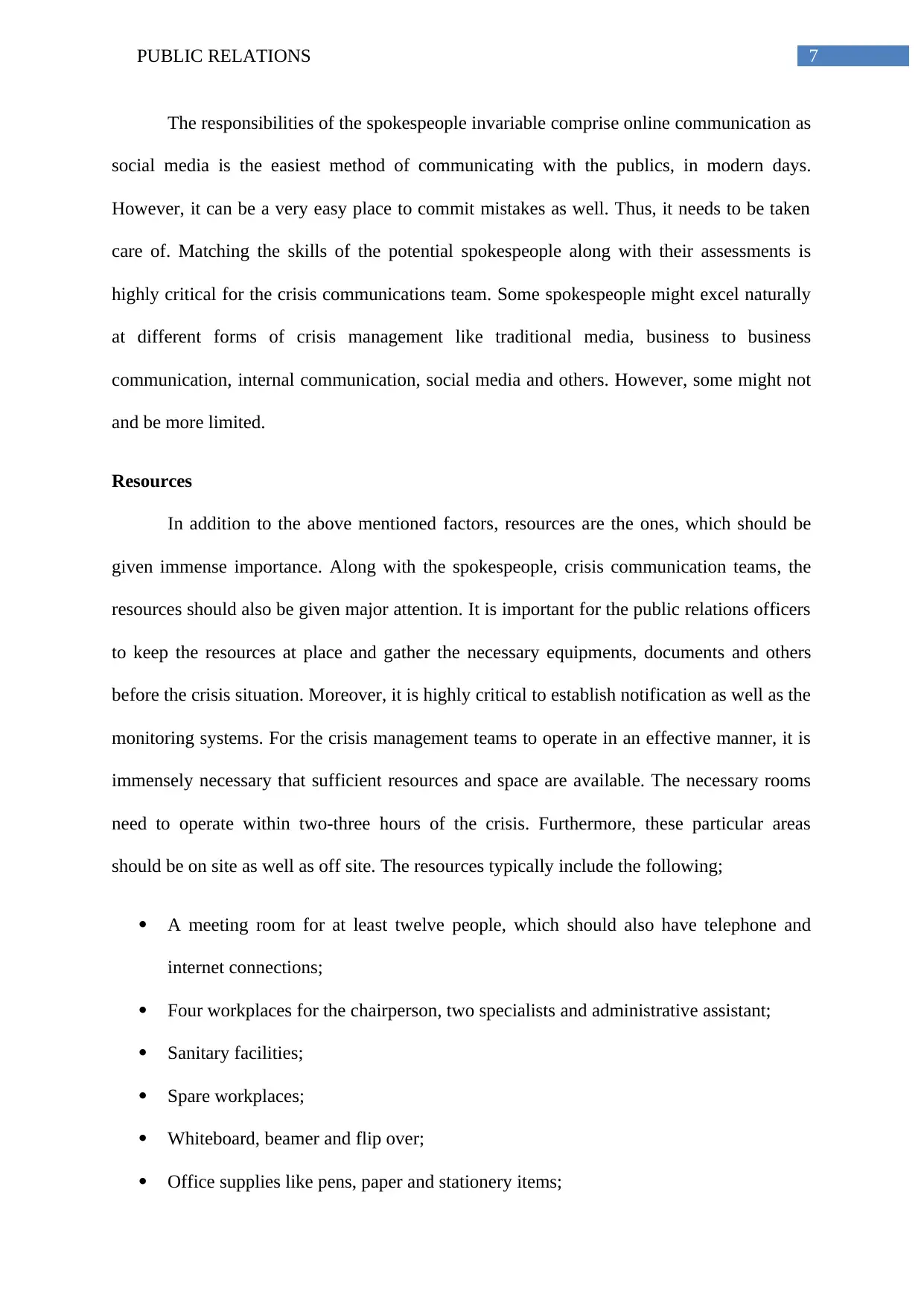
7PUBLIC RELATIONS
The responsibilities of the spokespeople invariable comprise online communication as
social media is the easiest method of communicating with the publics, in modern days.
However, it can be a very easy place to commit mistakes as well. Thus, it needs to be taken
care of. Matching the skills of the potential spokespeople along with their assessments is
highly critical for the crisis communications team. Some spokespeople might excel naturally
at different forms of crisis management like traditional media, business to business
communication, internal communication, social media and others. However, some might not
and be more limited.
Resources
In addition to the above mentioned factors, resources are the ones, which should be
given immense importance. Along with the spokespeople, crisis communication teams, the
resources should also be given major attention. It is important for the public relations officers
to keep the resources at place and gather the necessary equipments, documents and others
before the crisis situation. Moreover, it is highly critical to establish notification as well as the
monitoring systems. For the crisis management teams to operate in an effective manner, it is
immensely necessary that sufficient resources and space are available. The necessary rooms
need to operate within two-three hours of the crisis. Furthermore, these particular areas
should be on site as well as off site. The resources typically include the following;
A meeting room for at least twelve people, which should also have telephone and
internet connections;
Four workplaces for the chairperson, two specialists and administrative assistant;
Sanitary facilities;
Spare workplaces;
Whiteboard, beamer and flip over;
Office supplies like pens, paper and stationery items;
The responsibilities of the spokespeople invariable comprise online communication as
social media is the easiest method of communicating with the publics, in modern days.
However, it can be a very easy place to commit mistakes as well. Thus, it needs to be taken
care of. Matching the skills of the potential spokespeople along with their assessments is
highly critical for the crisis communications team. Some spokespeople might excel naturally
at different forms of crisis management like traditional media, business to business
communication, internal communication, social media and others. However, some might not
and be more limited.
Resources
In addition to the above mentioned factors, resources are the ones, which should be
given immense importance. Along with the spokespeople, crisis communication teams, the
resources should also be given major attention. It is important for the public relations officers
to keep the resources at place and gather the necessary equipments, documents and others
before the crisis situation. Moreover, it is highly critical to establish notification as well as the
monitoring systems. For the crisis management teams to operate in an effective manner, it is
immensely necessary that sufficient resources and space are available. The necessary rooms
need to operate within two-three hours of the crisis. Furthermore, these particular areas
should be on site as well as off site. The resources typically include the following;
A meeting room for at least twelve people, which should also have telephone and
internet connections;
Four workplaces for the chairperson, two specialists and administrative assistant;
Sanitary facilities;
Spare workplaces;
Whiteboard, beamer and flip over;
Office supplies like pens, paper and stationery items;
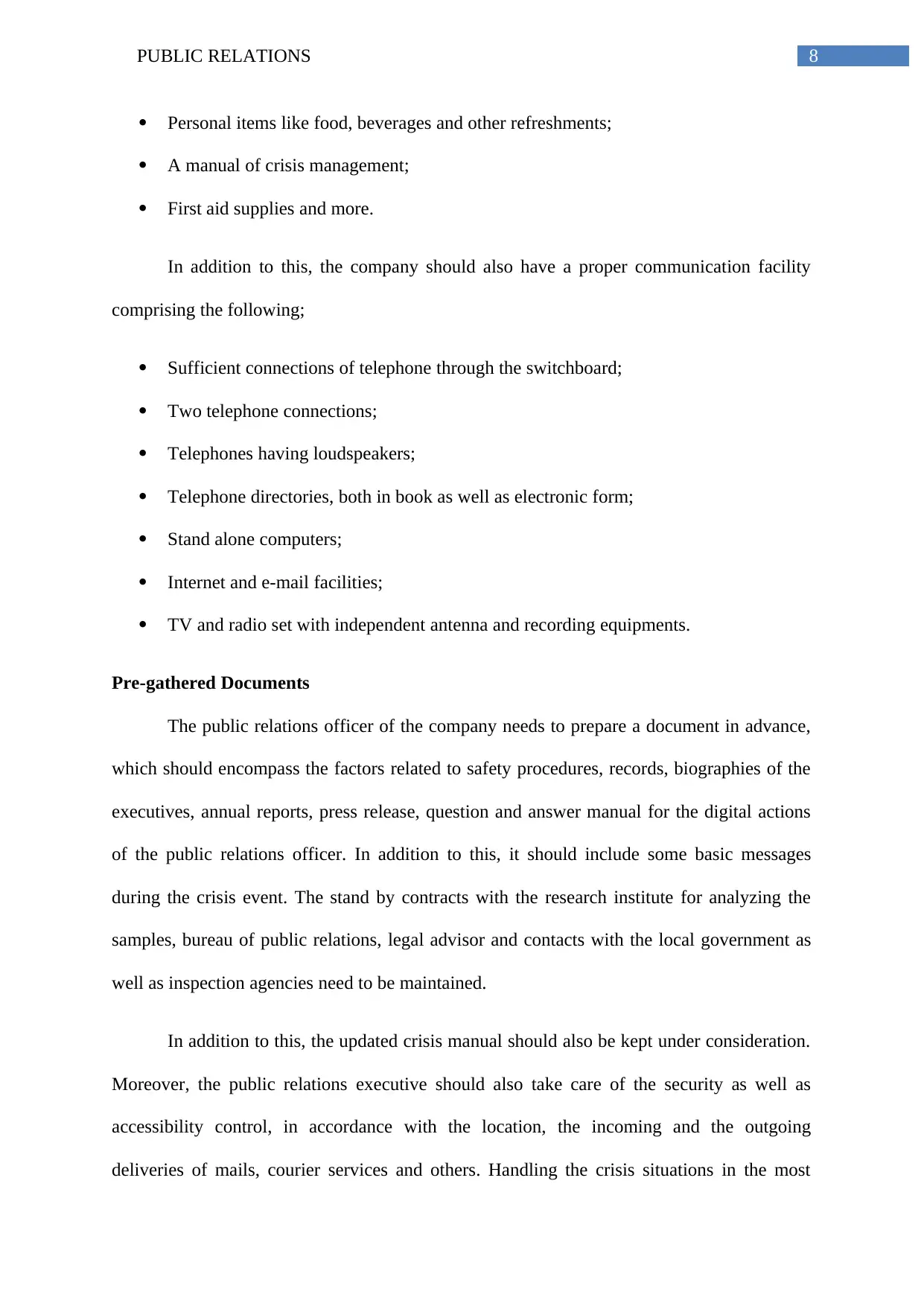
8PUBLIC RELATIONS
Personal items like food, beverages and other refreshments;
A manual of crisis management;
First aid supplies and more.
In addition to this, the company should also have a proper communication facility
comprising the following;
Sufficient connections of telephone through the switchboard;
Two telephone connections;
Telephones having loudspeakers;
Telephone directories, both in book as well as electronic form;
Stand alone computers;
Internet and e-mail facilities;
TV and radio set with independent antenna and recording equipments.
Pre-gathered Documents
The public relations officer of the company needs to prepare a document in advance,
which should encompass the factors related to safety procedures, records, biographies of the
executives, annual reports, press release, question and answer manual for the digital actions
of the public relations officer. In addition to this, it should include some basic messages
during the crisis event. The stand by contracts with the research institute for analyzing the
samples, bureau of public relations, legal advisor and contacts with the local government as
well as inspection agencies need to be maintained.
In addition to this, the updated crisis manual should also be kept under consideration.
Moreover, the public relations executive should also take care of the security as well as
accessibility control, in accordance with the location, the incoming and the outgoing
deliveries of mails, courier services and others. Handling the crisis situations in the most
Personal items like food, beverages and other refreshments;
A manual of crisis management;
First aid supplies and more.
In addition to this, the company should also have a proper communication facility
comprising the following;
Sufficient connections of telephone through the switchboard;
Two telephone connections;
Telephones having loudspeakers;
Telephone directories, both in book as well as electronic form;
Stand alone computers;
Internet and e-mail facilities;
TV and radio set with independent antenna and recording equipments.
Pre-gathered Documents
The public relations officer of the company needs to prepare a document in advance,
which should encompass the factors related to safety procedures, records, biographies of the
executives, annual reports, press release, question and answer manual for the digital actions
of the public relations officer. In addition to this, it should include some basic messages
during the crisis event. The stand by contracts with the research institute for analyzing the
samples, bureau of public relations, legal advisor and contacts with the local government as
well as inspection agencies need to be maintained.
In addition to this, the updated crisis manual should also be kept under consideration.
Moreover, the public relations executive should also take care of the security as well as
accessibility control, in accordance with the location, the incoming and the outgoing
deliveries of mails, courier services and others. Handling the crisis situations in the most
⊘ This is a preview!⊘
Do you want full access?
Subscribe today to unlock all pages.

Trusted by 1+ million students worldwide
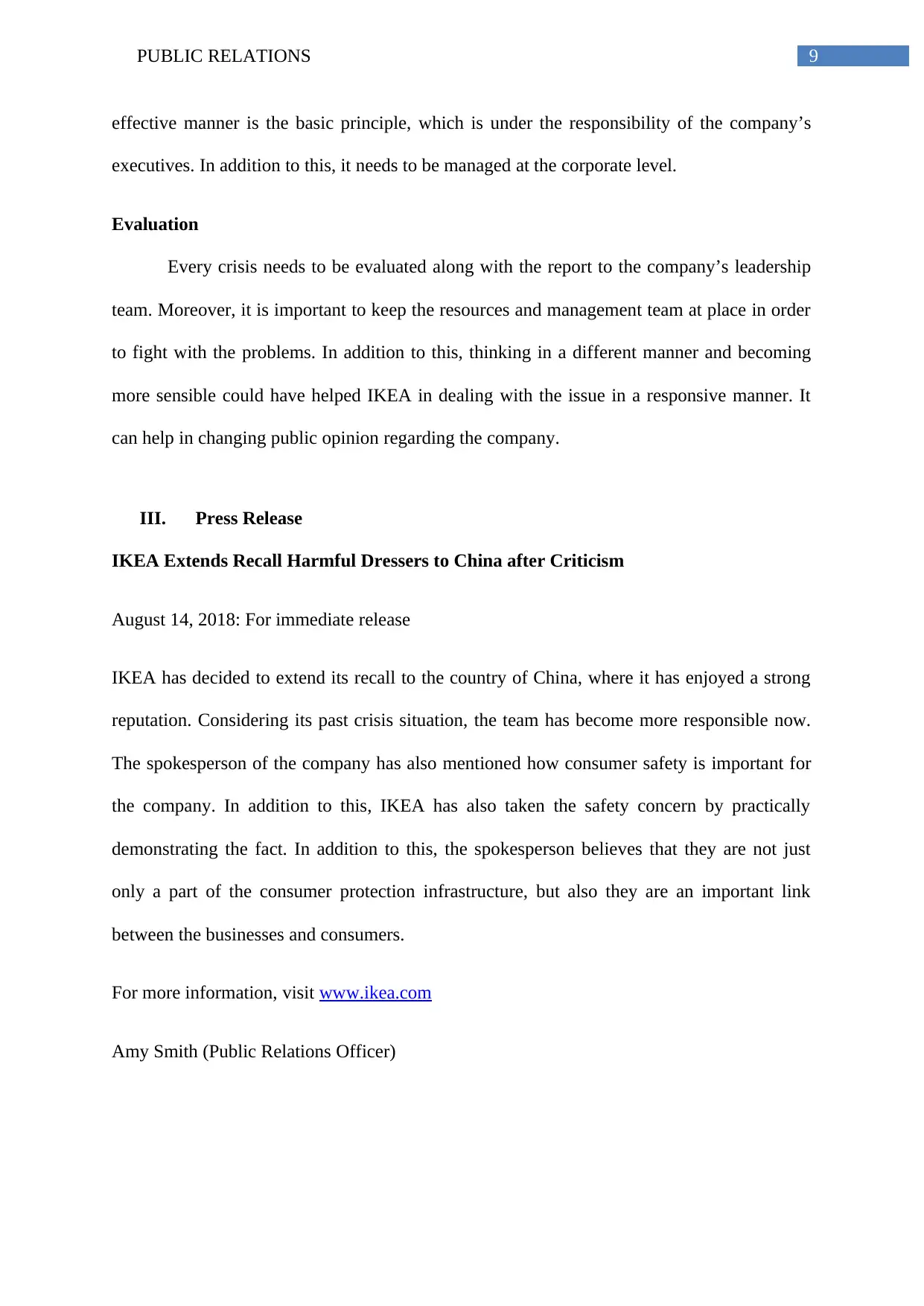
9PUBLIC RELATIONS
effective manner is the basic principle, which is under the responsibility of the company’s
executives. In addition to this, it needs to be managed at the corporate level.
Evaluation
Every crisis needs to be evaluated along with the report to the company’s leadership
team. Moreover, it is important to keep the resources and management team at place in order
to fight with the problems. In addition to this, thinking in a different manner and becoming
more sensible could have helped IKEA in dealing with the issue in a responsive manner. It
can help in changing public opinion regarding the company.
III. Press Release
IKEA Extends Recall Harmful Dressers to China after Criticism
August 14, 2018: For immediate release
IKEA has decided to extend its recall to the country of China, where it has enjoyed a strong
reputation. Considering its past crisis situation, the team has become more responsible now.
The spokesperson of the company has also mentioned how consumer safety is important for
the company. In addition to this, IKEA has also taken the safety concern by practically
demonstrating the fact. In addition to this, the spokesperson believes that they are not just
only a part of the consumer protection infrastructure, but also they are an important link
between the businesses and consumers.
For more information, visit www.ikea.com
Amy Smith (Public Relations Officer)
effective manner is the basic principle, which is under the responsibility of the company’s
executives. In addition to this, it needs to be managed at the corporate level.
Evaluation
Every crisis needs to be evaluated along with the report to the company’s leadership
team. Moreover, it is important to keep the resources and management team at place in order
to fight with the problems. In addition to this, thinking in a different manner and becoming
more sensible could have helped IKEA in dealing with the issue in a responsive manner. It
can help in changing public opinion regarding the company.
III. Press Release
IKEA Extends Recall Harmful Dressers to China after Criticism
August 14, 2018: For immediate release
IKEA has decided to extend its recall to the country of China, where it has enjoyed a strong
reputation. Considering its past crisis situation, the team has become more responsible now.
The spokesperson of the company has also mentioned how consumer safety is important for
the company. In addition to this, IKEA has also taken the safety concern by practically
demonstrating the fact. In addition to this, the spokesperson believes that they are not just
only a part of the consumer protection infrastructure, but also they are an important link
between the businesses and consumers.
For more information, visit www.ikea.com
Amy Smith (Public Relations Officer)
Paraphrase This Document
Need a fresh take? Get an instant paraphrase of this document with our AI Paraphraser
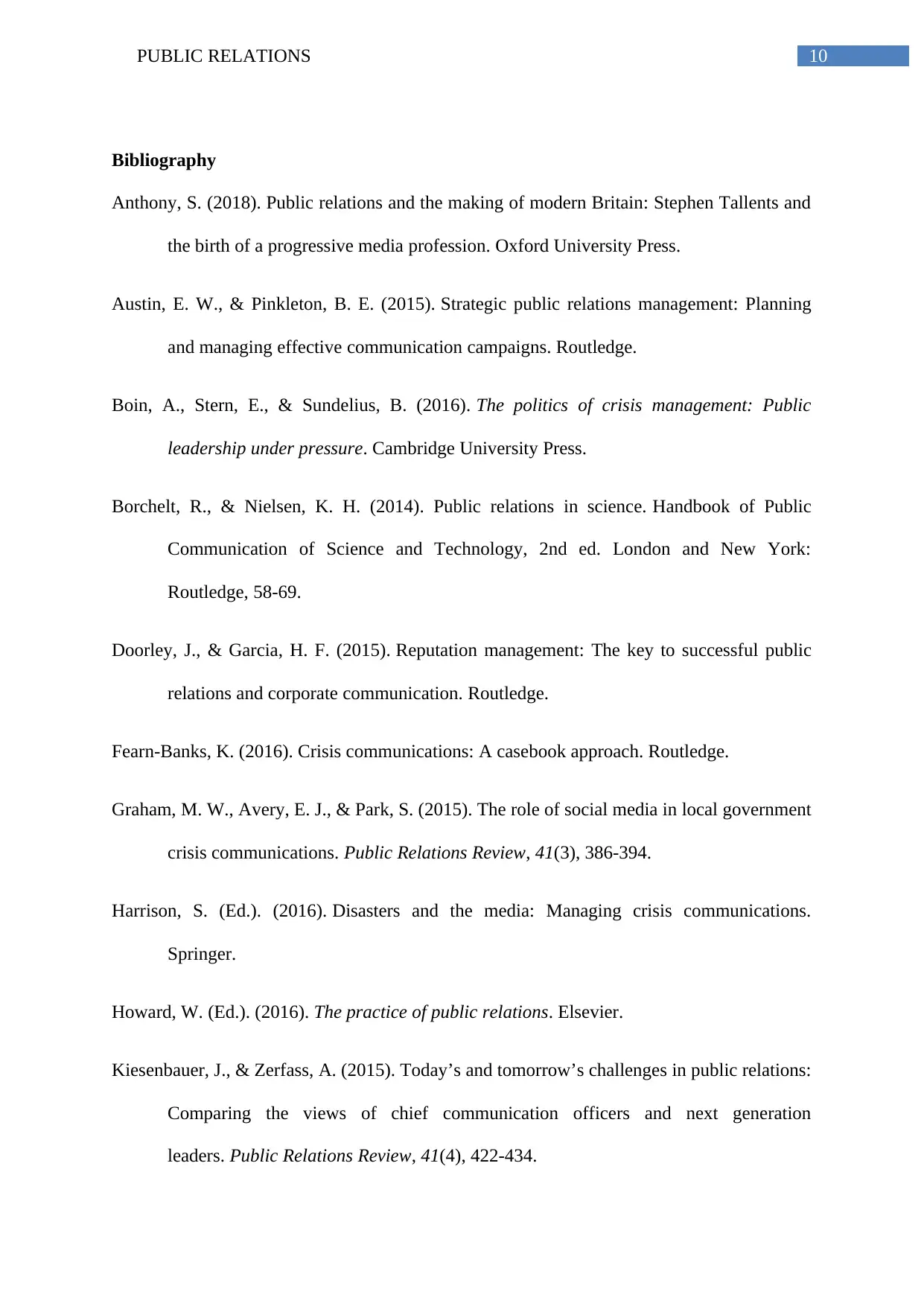
10PUBLIC RELATIONS
Bibliography
Anthony, S. (2018). Public relations and the making of modern Britain: Stephen Tallents and
the birth of a progressive media profession. Oxford University Press.
Austin, E. W., & Pinkleton, B. E. (2015). Strategic public relations management: Planning
and managing effective communication campaigns. Routledge.
Boin, A., Stern, E., & Sundelius, B. (2016). The politics of crisis management: Public
leadership under pressure. Cambridge University Press.
Borchelt, R., & Nielsen, K. H. (2014). Public relations in science. Handbook of Public
Communication of Science and Technology, 2nd ed. London and New York:
Routledge, 58-69.
Doorley, J., & Garcia, H. F. (2015). Reputation management: The key to successful public
relations and corporate communication. Routledge.
Fearn-Banks, K. (2016). Crisis communications: A casebook approach. Routledge.
Graham, M. W., Avery, E. J., & Park, S. (2015). The role of social media in local government
crisis communications. Public Relations Review, 41(3), 386-394.
Harrison, S. (Ed.). (2016). Disasters and the media: Managing crisis communications.
Springer.
Howard, W. (Ed.). (2016). The practice of public relations. Elsevier.
Kiesenbauer, J., & Zerfass, A. (2015). Today’s and tomorrow’s challenges in public relations:
Comparing the views of chief communication officers and next generation
leaders. Public Relations Review, 41(4), 422-434.
Bibliography
Anthony, S. (2018). Public relations and the making of modern Britain: Stephen Tallents and
the birth of a progressive media profession. Oxford University Press.
Austin, E. W., & Pinkleton, B. E. (2015). Strategic public relations management: Planning
and managing effective communication campaigns. Routledge.
Boin, A., Stern, E., & Sundelius, B. (2016). The politics of crisis management: Public
leadership under pressure. Cambridge University Press.
Borchelt, R., & Nielsen, K. H. (2014). Public relations in science. Handbook of Public
Communication of Science and Technology, 2nd ed. London and New York:
Routledge, 58-69.
Doorley, J., & Garcia, H. F. (2015). Reputation management: The key to successful public
relations and corporate communication. Routledge.
Fearn-Banks, K. (2016). Crisis communications: A casebook approach. Routledge.
Graham, M. W., Avery, E. J., & Park, S. (2015). The role of social media in local government
crisis communications. Public Relations Review, 41(3), 386-394.
Harrison, S. (Ed.). (2016). Disasters and the media: Managing crisis communications.
Springer.
Howard, W. (Ed.). (2016). The practice of public relations. Elsevier.
Kiesenbauer, J., & Zerfass, A. (2015). Today’s and tomorrow’s challenges in public relations:
Comparing the views of chief communication officers and next generation
leaders. Public Relations Review, 41(4), 422-434.
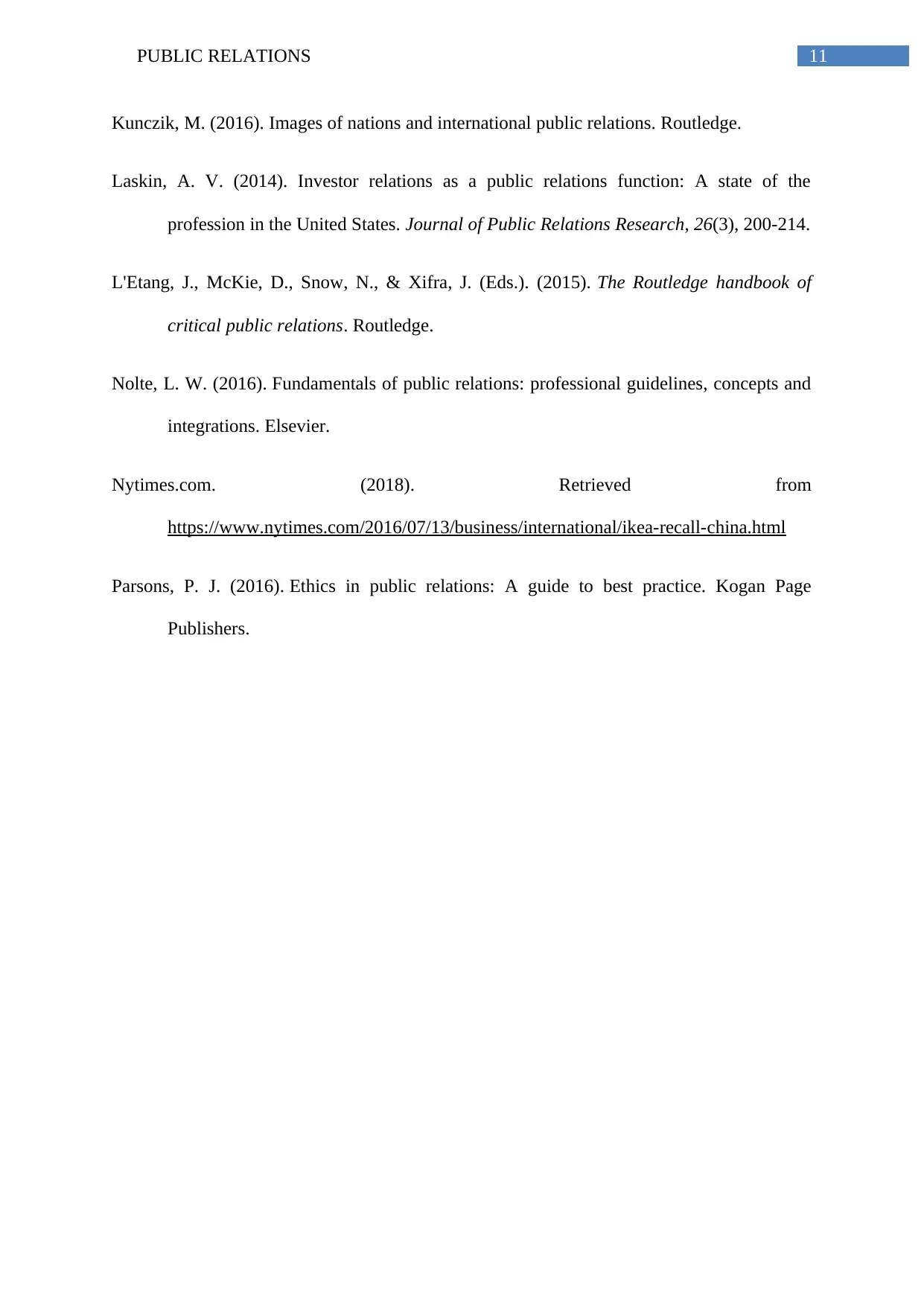
11PUBLIC RELATIONS
Kunczik, M. (2016). Images of nations and international public relations. Routledge.
Laskin, A. V. (2014). Investor relations as a public relations function: A state of the
profession in the United States. Journal of Public Relations Research, 26(3), 200-214.
L'Etang, J., McKie, D., Snow, N., & Xifra, J. (Eds.). (2015). The Routledge handbook of
critical public relations. Routledge.
Nolte, L. W. (2016). Fundamentals of public relations: professional guidelines, concepts and
integrations. Elsevier.
Nytimes.com. (2018). Retrieved from
https://www.nytimes.com/2016/07/13/business/international/ikea-recall-china.html
Parsons, P. J. (2016). Ethics in public relations: A guide to best practice. Kogan Page
Publishers.
Kunczik, M. (2016). Images of nations and international public relations. Routledge.
Laskin, A. V. (2014). Investor relations as a public relations function: A state of the
profession in the United States. Journal of Public Relations Research, 26(3), 200-214.
L'Etang, J., McKie, D., Snow, N., & Xifra, J. (Eds.). (2015). The Routledge handbook of
critical public relations. Routledge.
Nolte, L. W. (2016). Fundamentals of public relations: professional guidelines, concepts and
integrations. Elsevier.
Nytimes.com. (2018). Retrieved from
https://www.nytimes.com/2016/07/13/business/international/ikea-recall-china.html
Parsons, P. J. (2016). Ethics in public relations: A guide to best practice. Kogan Page
Publishers.
⊘ This is a preview!⊘
Do you want full access?
Subscribe today to unlock all pages.

Trusted by 1+ million students worldwide
1 out of 12
Your All-in-One AI-Powered Toolkit for Academic Success.
+13062052269
info@desklib.com
Available 24*7 on WhatsApp / Email
![[object Object]](/_next/static/media/star-bottom.7253800d.svg)
Unlock your academic potential
Copyright © 2020–2025 A2Z Services. All Rights Reserved. Developed and managed by ZUCOL.